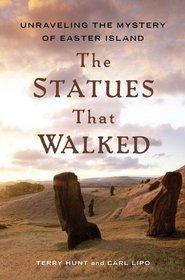 The Statues That Walked: Unraveling the Mystery of Easter Island by Terry Hunt and Carl Lipo [University of Baltimore and College Park Libraries, Call #: F3169 .H86 2011] Reviewed by Ivy Patterson Owens.
The Statues That Walked: Unraveling the Mystery of Easter Island by Terry Hunt and Carl Lipo [University of Baltimore and College Park Libraries, Call #: F3169 .H86 2011] Reviewed by Ivy Patterson Owens.
The archaeologist authors, Terry Hunt and Carl Lipo, went to Easter Island to excavate a sand dune in 2004. The layers within the dune seemed to disprove all previous scholarship about the island and its people. Previously, scholars had believed that Polynesians arrived in 700 AD but the radio carbon report indicated 1200 AD as the date. Because of this, the authors read all the accounts of ships visiting the island from the Dutch in 1722 to the Germans in 1882. They compiled what was said about the number of people and the vegetation on the island and there seemed to be fewer people and fewer palm trees as they read through the reports in chronological order. With further research the authors proposed explanations for these results.
Easter Island is noted for its Moai statues. In 1919 the archaeologist Katherine Rutledge and her husband lived on Easter Island and wrote a book about their experiences entitled Mystery of Easter Island: the Story of an Expedition [UMBC Library Special Collections, Call #: F3169 .H86] They noticed pathways from the volcano quarries to the coasts and believed the Easter Island statues were carved in the quarries and then moved by these roads to the coast where they were set up on stone platforms. In 1956 Thor Heyerdahl and the Norwegian Archaeological team mapped the whole island and published their results in a two volume work entitled Reports of the Norwegian Archaeological Expedition to Easter island and the East Pacific [St. Mary’s Library, Call #: F3269 .N67 1961]. Thor Heyerdahl proposed the theory that the huge statues were moved on their backs with a system of rollers. However, the Czech engineer, Pavel Pavel, believed the Moai were moved upright like moving a refrigerator. The native populations had always said that the statues had “walked.” In 1986 Thor Heyerdahl invited Pavel Pavel to Easter Island to try out his method. Using only 16 men, they were able to “walk” an upright Moai statue 600 feet per day. The results of this experiment were published in Easter Island—the Mystery Solved [UMBC, College Park, and Morgan Libraries, Call #: F3169 .H4513 1989]
Other experiments continue to this day for building the stone platforms and moving the statues. The native population often dismissively asks the archaeologists if they don’t have huge statues where they come from! This book is a fascinating read.